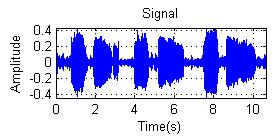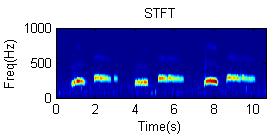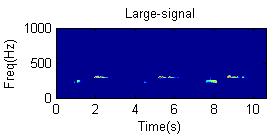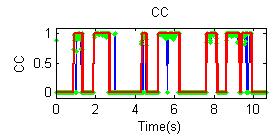Wheeze, as a type of abnormal lung sounds, is observed in patients with pulmonary diseases such as chronic obstructive pulmonary disease or asthma. Currently, auscultating and X-ray imaging are popular and fast methods to diagnose pulmonary diseases related with wheeze. However, both the methods are subjective and depend on the physician’s experience. In addition, X-ray imaging is harmful to patients. Recently, researchers from the Institute of Acoustics of the Chinese Academy of Sciences work together and have found automatic and noninvasive way to detect wheeze.
The proposed method consists of short-time Fourier transform decomposition, preprocessing of the spectrogram, correlation-coefficients calculating and duration determining. And preprocessing comprises detrending and large-signals detecting. Here, large-signals are defined as the amplitude spectrum signals whose values are greater than the empirical threshold.
Afterwards, the correlation-coefficients of large-signals are utilized to determine the lung sound. It calculates the correlation-coefficients of large-signals and then determines the duration of high correlation-coefficients which are greater than the correlation-coefficients threshold. If these high correlation-coefficients last more than the wheeze duration (150ms), this segment of lung sound, which the high correlation-coefficients correspond to, will be judged as wheeze, as depicted in Fig. 1.

a. Signal

b. short-time Fourier transform

c. Large-signals

d. Simulation result
Fig. 1 An detecting example of wheeze (Image by LI Jiarui)
Particularly, better than the past method, the determining of duration is based on Haas effect. It takes into account that there are some correlation-coefficients less than the threshold which gives rise to the discontinuity of high correlation-coefficients and then causes error in wheeze detection. Haas effect points out that only when the time interval between two sound signals exceeds 35ms, can humans distinguish between these two sounds. Hence, according to Haas effect, if the time interval between two high correlation-coefficients is less than the threshold of Haas effect, these two correlation-coefficients are considered continuous.
Simulation result shows that the sensibility (SE), the specificity (SP) and the accuracy (AC) are 88.57%, 97.78% and 93.75%, respectively, which indicates that this method could be an efficient way to detect wheeze.
Reference:
LI Jiarui, HONG Ying, HAO Chengpeng. Wheeze Detection Algorithm Based on Correlation-coefficients Analysis. IEICE Transactions on Fundamentals of Electronics, Communications and Computer Sciences (Vol.E99-A, No.3, March 2016, pp.760-764).
Contact:
LI Jiarui
Institute of Acoustics, Chinese Academy of Sciences, 100190 Beijing, China
Email: lijiarui12@mails.ucas.ac.cn


